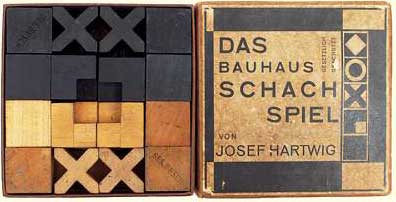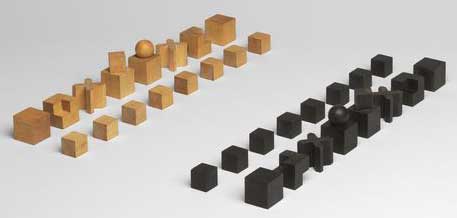|

Dr. Gregory Zilboorg
(1890 - 1959)
It's said that Dr. Zilboorg, when
he first arrived in the United States, spoke only Russian and French, but he
secluded himself in his room for three months during which he learned
impeccable English. Zilboorg was a prominent psychoanalyst in NYC. He
apparently collected art and played chess. He is listed on the brochure as one
of the players in the blindfold demonstration, though he was replaced.
He contribution to the Imagery of Chess show was the prototype Bauhaus
chess set from 1924 built by Josef Hartwig.

Joseph Hartwig's 1924 Bauahus chess set
Notice how the piece design attempts to mimic the movement of the piece


all the pieces tuck away neatly inside the box

the Bauhaus pieces on display at
MOMA
Staatliches Bauhaus was a school of art or
perhaps even an art movement all to itself.
It's founder, Walter Gropius, wrote in the
Bauhaus manifesto:
 The ultimate aim of all creative activity is a building! The decoration of
buildings was once the noblest function of fine arts, and fine arts were
indispensable to great architecture. Today they exist in complacent isolation,
and can only be rescued by the conscious co-operation and collaboration of all
craftsmen. Architects, painters, and sculptors must once again come to know
and comprehend the composite character of a building, both as an entity and in
terms of its various parts. Then their work will be filled with that true
architectonic spirit which, as "salon art", it has lost.
The ultimate aim of all creative activity is a building! The decoration of
buildings was once the noblest function of fine arts, and fine arts were
indispensable to great architecture. Today they exist in complacent isolation,
and can only be rescued by the conscious co-operation and collaboration of all
craftsmen. Architects, painters, and sculptors must once again come to know
and comprehend the composite character of a building, both as an entity and in
terms of its various parts. Then their work will be filled with that true
architectonic spirit which, as "salon art", it has lost.
The old art schools were unable to produce this unity; and how, indeed, should
they have done so, since art cannot be taught? Schools must return to the
workshop. The world of the pattern-designer and applied artist, consisting
only of drawing and painting must become once again a world in which things
are built. If the young person who rejoices in creative activity now begins
his career as in the older days by learning a craft, then the unproductive
"artist" will no longer be condemned to inadequate artistry, for his skills
will be preserved for the crafts in which he can achieve great things.
Architects, painters, sculptors, we must all return to crafts! For there is no
such thing as "professional art". There is no essential difference between the
artist and the craftsman. The artist is an exalted craftsman. By the grace of
Heaven and in rare moments of inspiration which transcend the will, art may
unconsciously blossom from the labour of his hand, but a base in handicrafts
is essential to every artist. It is there that the original source of
creativity lies.
Let us therefore create a new guild of craftsmen without the
class-distinctions that raise an arrogant barrier between craftsmen and
artists! Let us desire, conceive, and create the new building of the future
together. It will combine architecture, sculpture, and painting in a single
form, and will one day rise towards the heavens from the hands of a million
workers as the crystalline symbol of a new and coming faith.

The history of Staatliches Bauhaus in non-lineal
and very complex. Concisely, it was founded in 1919 in Wiemar where it built a
solid reputation for excellence until budget restrictions force it to close
and reopen in Dessau where funding was more readily available and where it
eventually turned profitable. Unfortunately, the situation in Germany itself
was unstable and Bauhaus moved again in 1932, this time to Berlin where it was
forced to close in 1933 under pressure from the Nazi party. Many great
artists, including Paul Klee, Wassily Kandinsky, Gunta Stölzl, Piet Mondrian,
László Moholy-Nagy taught or lectured at Bauhus.

a 1924 advertisement for Hartwig's chess set
The Bauhaus school believed that craftsmanship
and fine art should be united and that the distinction between the two was an
artificial one: all artists were merely elevated craftsmen and all craftsmen
should be artists. Besides the aesthetical aspect, craftsmen must also be
concerned with the practical side of their work, such as availability of
materials, costs and production techniques. In order to accomplish this goal,
Bauhaus employed a craft system. Beginning students were called apprentices.
After three semesters they could sit for their journeyman's exams. Upon
passing these exams, they could enter a course of study that would allow them
to become masters of craft. Each workshop (metal, weaving, pottery, furniture,
typography and wall painting - not counting the art and architecture schools)
employed a master of form and a master of crafts to involve the students in
both the aesthetical and the technical sides of their work.
Josef Hartwig was a master of craft in the
furniture workshop. He was born in Munich on March 13, 1880 and died in
Frankfurt on November 13, 1856. Thirteen was both his lucky and unlucky
number.
Hartwig created the chess set as well as a chess
table and chair:


|

